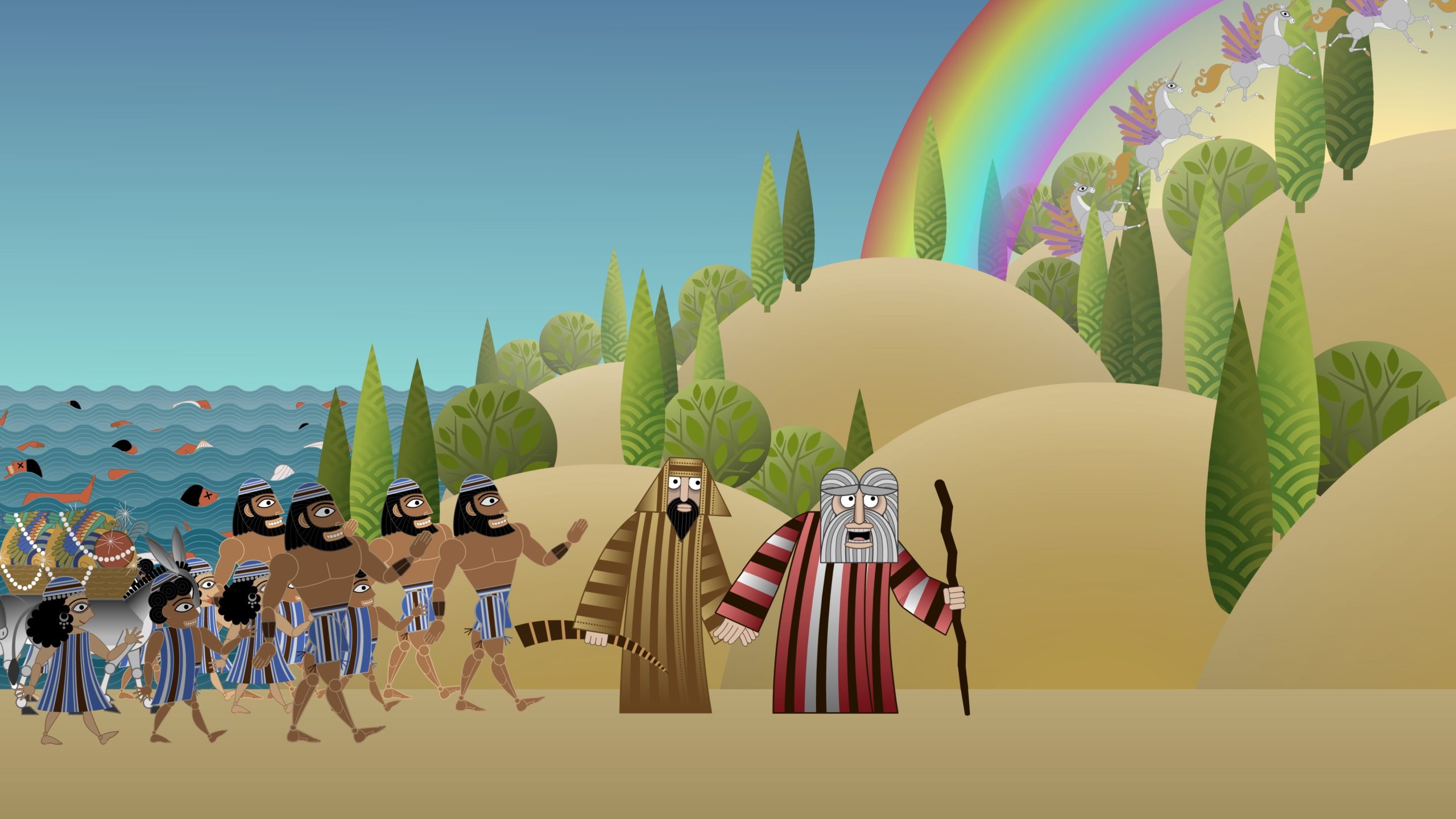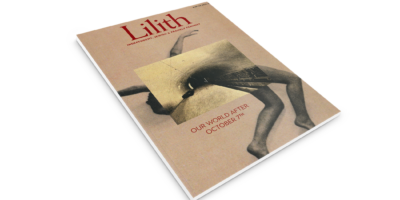
Seder-Masochism: Beyond the Orange and Miriam’s Cup
By now these items are standard fare at a feminist seder – the once transgressive orange on the Seder Plate; Miriam’s cup of clear, life-giving water next to Elijah’s cup of blood red wine.
But wait! Most of us have yet to dig beneath the God and Moses Exodus story, even with Aviva Cantor’s “Jewish Liberation Hagada” — second edition now 50 years old [1971] — and Lilith’s publication of her egalitarian Haggadah over 39 years ago (March 1982).
While the season of questions is still upon us, get thee to Nina Paley’s Seder-Masochism, an animated musical that can be found on on Vimeo.
Paley is celebrating the true, ancient form of religion — the goddesses and fertility figures worshipped before God delivered the 10 commandments to Moses and Moses put the kibosh on the Golden Calf. She depicts the great idol as a giant four-footed female with rows of golden tits – more sacred cow goddess than calf.
Seder-Masochism opens in monochromatic beauty with an all-powerful female figure silhouetted against a starry sky. A snake winds its way around her curvaceous body. Woman’s all-mighty womb vibrates in harmony with the phases of the moon. Birds, beasts, fish move Escher-like through their elements. Sperm-like snakes morph into mighty trees. All of this is set to the other-worldly music of the Bulgarian State Radio and Television Female Vocal Choir singing “Godmother Denkou.” This idyllic age ends violently as a man with an ax fells one of the mighty trees. But roots remain.
Cut to the cast of seder characters. Moses and his herd are tap dancing à la Busby Berkeley. Jesus leading Last Supper seder speaks in the voice of a yesteryear white male broadcaster. God the Father – in this case, Nina Paley’s father – comes with streaming white beard and hair topped by crimson crown, face collaged from the pyramid eye on the dollar bill. He reluctantly digs into his memory to chant the seder opening. God the Father, no longer a believer, is being questioned by his daughter in the form of a little black scapegoat. But wait! Next, a tiny Moses is overwhelmed by legions of goddess figures dancing to “You’ve got to believe in somethin’ / Why not believe in me.” We’re back to our roots – all our roots.
The spectacularly visual hour and 17 minutes, with messages of death, destruction, liberation and more death and destruction, comes with great music – Louis Armstrong singing “Go Down Moses,” “Hail, Hail the Gang’s All Here” (for the obvious plague), “Give Me That Old Time Religion” (when God was a woman?), Guns N’ Roses’ “Used to Love Her,” but I had to kill her.
The reappearing chorus lines of undulating fertility figures are endearing. Who wouldn’t love the dancing Venus of Willendorf chubbettes, with their pendulous breasts, bulging hips and bellies – 25,000 years young. And the chorus line duplicates the magnificent winged Sumarian goddess. She’s the earliest known deity on record, an early Lilith figure. She’s shapely by contemporary standards, until you reach the giant claws at the ends of her legs. Yikes.
The goddesses have been replaced by One God, who shalt kill all the firstborns of Egypt (presumably males; females don’t count), while sparing His chosen people (us). The goddesses are driven underground as church, synagogue and mosque devoted to a patriarchal god rise above them. In perhaps the most upsetting image, man with ax cleaves the original curvaceous female figure in two, top and bottom. He picks up her limp split halves and absorbs them into his body. It’s as if the matriarchy never existed.
But Seder-Masochism is truly a guide to the seder told by Moses, Jesus, the Angel of Death and Nina Paley’s father. In a very personal questioning between generations, the little black scapegoat keeps peppering God the Father with questions about his discarded Judaism. (Could God be questioned out of believing in Judaism?) The touching exchange between father and daughter, with loving father Hiram Paley still giving daughter Nina a hard time, certainly resonates. At the end of his life, he’s annoyed that she’s fussing with the mic pinned to his (hospital?) gown. Above all, he’s upset at her for dropping out of college, “stupidity on your part,” leaving her financially insecure. At least he’s not telling her to find a reliable, financially secure man to marry.
The traditional haggadah’s final message, “Next Year in Jerusalem!” is just the lead-in to the Seder-Masochism final tour-de-force (literally). To the strains of “This Land Is Mine” – land mine is more like it — (music by Ernest Gold, lyrics by Pat Boone, performed by Andy Williams) one group of men after another destroys a competing group of men from the ancients’ bows and arrows to the swords of the Crusaders, the Brits’ cannon, black-hatted Jews’ pistols, Arab scimitars then grenades and bombs, to the grand finale of the Angel of Death above atomic bombs.
But thank you, Paley, for not leaving us in total despair. Some great music and joyful goddesses return for the credits. Credits abound but Nina Paley is writer, director, animator and producer. (The film is not posted on YouTube since its censor-bots don’t recognize Fair Use. Fans have posted there, but be forewarned, the YouTube video is missing audio near the end.)
She embarked on Seder-Masochism the year her father died, 2012, and completed it six years later. Totally opposed to copyright, she produced Seder-Masochism for a mere $20,000 with some great copyrighted music available under “Fair Use.” Her unorthodox distribution is truly free. Under public domain, anyone can re-use, remix and redistribute Seder-Masochism. Seder-Masochism the book is available, “engraved on demand” through Amazon (sometimes you just have to go with the establishment). But Paley is not encouraging us to buy stuff we don’t need. On the other hand, the thought of families gathered around the Passover table with orange on seder plate, Miriam’s cup beside Elijah’s, and everyone on the same page of their copy of Seder-Masochism suggests a true festival of freedom, or at the very least a recognition of our roots.



